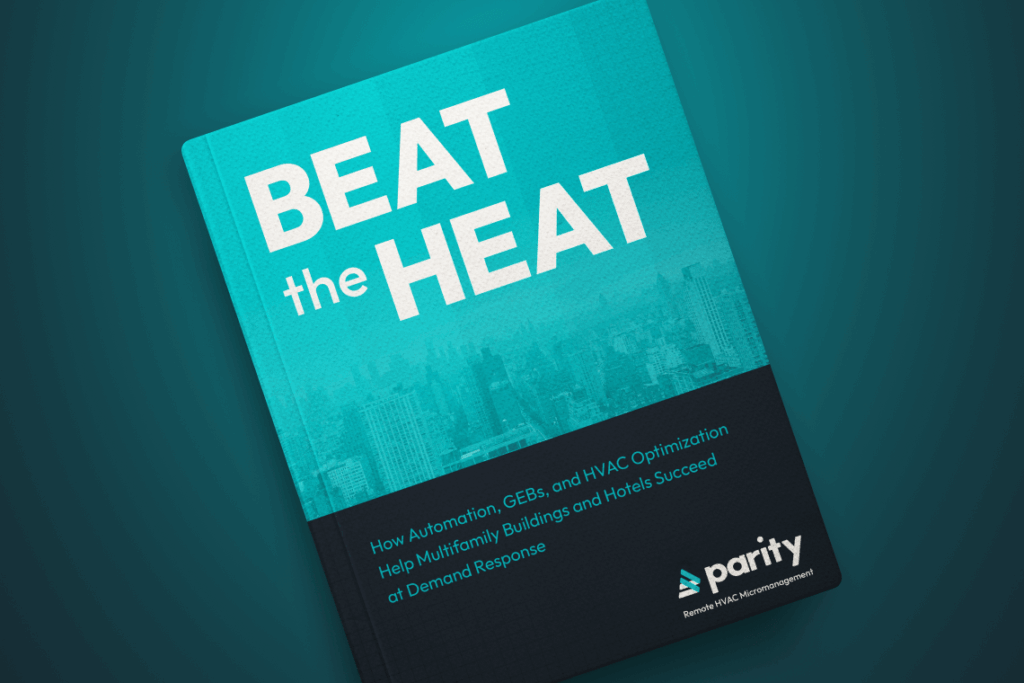
New White Paper on how Multifamily Buildings and Hotels can Save Energy and Generate Revenue Through Demand Response Events.
Toronto, ON – 09:00 EST, October 16th, 2025 – Parity, the leader in Remote HVAC Optimization, has released a new white paper showcasing how its service enables multifamily buildings and hotels to seamlessly participate in demand response (DR) events. What was once a manual, staff-intensive process can now be fully automated, transforming properties into grid-responsive assets that save time and energy, while also generating a new revenue stream for real estate owners.
With extreme heat intensifying and additional strain on the electrical grid from AI, data centers, and renewable power generation, the need for smarter buildings has never been greater. HVAC systems alone account for 35% of a building’s total energy use, the single largest operational load. Parity’s Optimizer service addresses this by connecting to existing HVAC systems or a building management system (BMS). It’s the same Optimizer service that also enables multifamily and hotel properties to participate in demand response events.
“We’re excited to release this white paper as it highlights the advancements we are making within the industry,” said Brad Pilgrim, CEO and Co-Founder of Parity. “Automating demand response turns what was once a reactive, manual process into a seamless, high-value capability. As grid pressures mount, the ability to intelligently reduce HVAC load without sacrificing comfort is more than a nice-to-have; it’s becoming essential. Parity is proud to continue to innovate and lead, showing how smarter grid-responsive buildings can deliver both financial and environmental returns.”
On DR events, Molly Jerrard, Head of Flexibility at Enel North America, explained that “The electric system always has to be in balance.” Jerrard noted that, “There always has to be enough supply to meet demand. And demand response historically has [involved] paying energy users to shut down during times of peak stress. Because, in a very basic economic equation, a negative megawatt of demand has the same impact as a positive megawatt of supply on the electric system.”
However, DR events have previously been challenging for multifamily buildings and hotels. Staff were required to manually adjust HVAC systems, a process that was often unreliable and largely avoided to protect occupant comfort. As a result, many of these properties were effectively excluded from DR programs.
With a steady increase in DR events every year, the need to react manually becomes increasingly problematic. Ali Shehu, Resident Manager at 525 West 52nd Street in Manhattan, described the experience: “Before Parity came in, we had to shut everything off manually.” Shehu noted that often this process meant that 525 could only partially participate in an event, showing up late if it arrived at all.
Parity’s AI-driven HVAC optimization service, Optimizer, is positioned to help buildings evolve into Grid-Interactive Efficient Buildings (GEBs). GEBs allow dynamic interaction with the grid, enabling HVAC systems to change energy usage to off-peak times, lower utility costs, cut emissions, and participate in demand response programs. With Parity, this is done automatically and without compromising occupant comfort.
In 2024, Parity-enabled buildings realized over $250K in revenue from DR events across 30 properties, and with more than 60 buildings enrolled for 2025, those revenues are projected to rise significantly.
James Hannah, Managing Director at Parity, explained, “We’re striking the right balance between maintaining comfort and not leaving any revenue on the table. The sophistication of our system, its ability to fine-tune operations in real time, is what sets Parity apart and ensures our customers receive the best returns.”
The release of this white paper highlights Parity’s mission to redefine building performance. As multifamily and hotel owners seek ways to increase revenue, lower utility costs, and align with sustainability targets, the paper demonstrates how the automation and optimization of HVAC during DR events can deliver tangible value.
Parity is fast approaching 100 million square feet of real estate under management and raised $19 million in Series B funding last year. Their AI-driven service remotely optimizes HVAC systems, reducing utility costs by up to 30%.
You can download the white paper here.